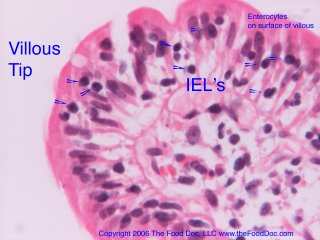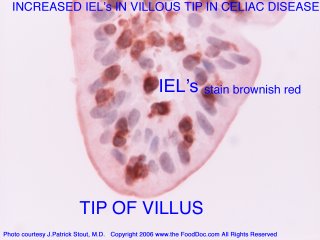The Food Doc (www.theFoodDoc.com) explains with photos intra-epithelial lymphocytosis in Celiac disease.

• Lymphocytes are a type of white blood cell important in immune function. The typically appear as purplish circles on standard H&E type stain of intestinal tissue obtained from biopsy.
• Specialized lymphocytes are present in the intestine lining.
• The intestinal lining cells are called enterocytes and are a type of epithelial cell.
• The intestinal lining is an epithelial lining.
• Lymphocytes that are activated and migrated up from crypts at the base of the intestine villi to the tip are called intra-epithelial lymphocytes.
• Normally, there are much fewer than 25-30 lymphocytes per 100 enterocytes in each villous or < 9 per villous tip.
• For thirty years, more than 40 IEL’s/100 enterocytes was considered abnormal and diagnostic of Celiac in the context of appropriate history and abnormal celiac blood tests. It is the number still used by many pathologists.
• More recently, 30 intra-epithelial lymphocytes per 100 enterocytes (6 or more IEL’s per 20 enterocytes) became the accepted criteria for intra-epithelial lymphocytosis and diagnosis of Celiac disease when villous blunting or atrophy are absent but blood tests are positive.
• Newer studies suggest that <25 IEL’s per 100 enterocytes should be the cut off for abnormal and 20-25 IEL’s/100 enterocytes is borderline and suggestive of gluten injury.
Special stains highlight IEL's in intestinal villi in Celiac disease

• IEL’s are easier to see and count with special immune chemistry stains.
• Above is a photomicrograph showing increase IEL’s in a villous tip in Celiac disease. The IEL’s are brownish red with this particular stain whereas normal intestinal cell nuclei are purplish.
• Sometimes this stain is necessary to determine IEL’s from normal intestinal nuclei and better determine the number, especially if someone has already restricted gluten in their diet.
• Studies have shown that apparently normal appearing small intestine biopsies when stained with special stains for IEL’s reveal abnormal numbers as the earliest sign of gluten injury, especially in high risk individuals like family members of people with Celiac disease.
For more information see www.theFoodDoc.com. Coming soon to www.theFoodDoc.com, a premier website with online symptom assessment tool, info wizard, online symptom diet diary, virtual office, reference material, resources, and much more. Secure online consultation now available at www.theFoodDoc.com.
Copyright © 2006 The Food Doc, LLC www.theFoodDoc.com All Rights Reserved
Above all else, guard your heart, for it affects all you do. Proverbs 4:23
